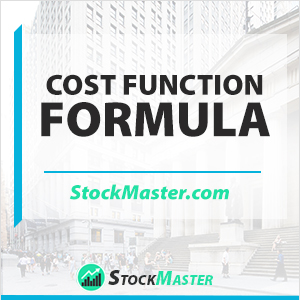 What is the Cost Function Formula?
What is the Cost Function Formula?
Definition: The cost function formula calculates the total fixed and variable costs that are required to produce a product. Management uses this formula to analysis whether production of product should stop or continue.
To know whether it is making profit or losses, it necessary that a business or company monitors its productivity activities. It can be achieved through the cost function formula. Using it means the company puts into account variable and fixed costs to arrive at the cost of production. It is applicable for different product lines or at different levels of productivity.
Cost Function Formula Components
The cost function formula is also applicable during the budget making process; thank to its outline which is:
C(x) = F + Vx
C = Total Expenses
X = Number of Units Produced
F = Fixed Costs
V = Variable Costs.
We must remember that fixed costs remain unchanged despite the level of production, and they include machinery costs, rent, or insurance payments. On the other hand, variable costs, which include labor and materials, will change from time to time and have a direct relationship to the level of production.
Cost Function Formula Example
ROG Company manufacture iron sheets and uses the cost function formula frequently when preparing its budget. It is the tool, which determines the company’s ideal product mix. Its fixed related costs amount to $100,000.
The company produces 60,000 feet of iron sheets whereby each foot costs $3.50
Here is how ROG yields the cost function formula calculation
C(x) = F + Vx
Cost = $100,000 + $3.50 (60,000)
Cost = $100,000+210,000
Cost = $310,000
With this, ROG can easily make decisions on whether or not it is worth producing 60,000 pieces of iron sheets, more or less, and what kind of profit should it expect?
Cost Function vs. Profit Function
Is there are a difference in the two function formulas? Yes, there is. While the cost function charts the way forward on the company’s expenses, the profit function builds a relationship between total profit and output.
Thus it is two in one the revenue and cost function. Any increase in a company’s production is likely to increase the profit, but the average cost will fall if the economies of scale are not strong.
Profit Function Calculation
With its representation of revenue and cost function we could easily say R(x) = the revenue function and C(x) = the cost function. This means P(x) = R(x) – C(x).
A merchandiser seller sells sweet cakes at $5.00 each. His revenue is, therefore, 5x (Rx). Every day, he pays $100 for his business outlet, whereby this is a fixed cost. The materials for making each cake cost (the variable costs) $3 per cake.
Meaning his cost function is C(x) is 100 + 2.90. So how many sweet cakes will the merchandiser have to sell to make a profit?
Cost Function Breakeven Point Calculation
R(x) = C(x). 5x = 100 + 3x. x = 100
It means the merchandiser has to sell not less than 100 cakes every single day to breakeven. The implication is that the profit will increase if he can sell more than 100 cakes each day, and he makes $2.00 extra on each extra cake after 100.
A breakeven analysis, which is a must-have tool for every business, defines a company’s level of productivity. It helps the company project on its profit and acts as a comprehensive guide for evaluating its performance.
It is part of a business plan since it builds cost structures. It also outlines the number of units that would bring a profitable margin. However, even as the business runs, breakeven analysis is applicable. It plays a significant role in the pricing and promotion processes. Additionally, it comes in handy during cost control.
Fixed Costs/ (Unit Selling Price – Variable Costs) = Break-even Point
The recovery of a breakeven point means the company has recovered all its costs, both fixed and variable, and anything after this is an additional profit. The bottom line is that a breakeven analysis acts as a tool of safety for business.
